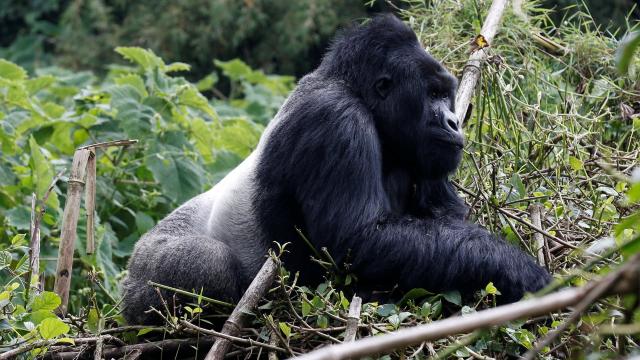
An endangered silverback high mountain gorilla from Sabyinyo family walks inside a forest in the Volcanoes National Park near Kinigi, north-western Rwanda. Photograph: Thomas Mukoya/Reuters
The vast majority of the world’s largest species are being pushed towards extinction, with the killing of the heftiest animals for meat and body parts the leading cause of decline, according to a new study.
While habitat loss, pollution and other threats pose a significant menace to large species, also known as megafauna, intentional and unintentional trapping, poaching and slaughter is the single biggest factor in their decline, researchers found.
An analysis of 362 megafauna species found that 70% of them are in decline, with 59% classed as threatened by the International Union for Conservation of Nature. Direct killing by humans is the leading cause across all classes of animals, the study states. A range of maladies including intensive agriculture, toxins and invasive competitors are also helping to trigger these declines.
This situation adds to the “mounting evidence that humans are poised to cause a sixth mass extinction event”, according to the research, published in Conservation Letters. It adds that “minimizing the direct killing of the world’s largest vertebrates is a priority conservation strategy that might save many of these iconic species and the functions and services they provide.”
Humans cause the deaths of large creatures in a variety of ways, from snares that entangle mountain gorillas and the poaching of elephants for ivory to the killing of the Chinese giant salamander, which can grow up to 6ft long and is considered a delicacy in Asia.
“Sometimes the killing is legal, sometimes illegal and sometimes unintentional, such as by catch during fishing,” said William Ripple, lead author and a professor of ecology in the Oregon State University. “If this trend continues we will lose many of its megafauna species and the world will become an impoverished place. We are heading towards them dwindling away.”
Humans have hunted the largest animals for thousands of years but technology has allowed them to be targeted far more efficiently, the study notes, with nine megafauna species becoming extinct in the past 250 years, including two types of giant tortoise and two varieties of deer.
Besides the intrinsic value of imposing creatures such as rhinos, sharks and tigers, many of them perform an important ecological role as predators at the top of the food web or by spreading seeds throughout habitat.
The industrialized slaughter of livestock for food, along with well-regulated hunting, isn’t to blame for the loss of species, the research found, although other studies have illustrated the sweeping environmental harm caused by mass agriculture.
“It’s a complex issue. Sometimes large animals are killed for trophies, sometimes it’s subsistence hunting and fishing, sometimes its illegal poaching – it runs the gamut,” Ripple said. “Humans have become super predators who don’t even have to come into contact with the things we are killing. Many of these large animals have low reproduction rates so once you add in that pressure they become vulnerable.”
The crisis in the natural world has been laid bare by recent research, which illustrated that only 4% of the world’s mammals, by weight, are wild, with the other 96% made up of humans and livestock. Since 1970, populations of wild mammals, birds fish and amphibians have, on average, slumped by 60%.
Conservationists have called for a radical overhaul that would require an end to mass deforestation and the setting aside of a third, or maybe even half, of the world to nature. Looming challenges posed by climate change and a rapidly increasing human population will also have to be met if the losses are to be stemmed.
“We need international treaties that work, we need to take action together to save these species,” Ripple said. “We’ve made progress with some species, such as whales through the International Whaling Commission. We need governments to work together for other megafauna.”
The research is “another log on the fire and follows a known, disturbing narrative that we are killing species to extinction,” said Erle Ellis, an ecologist at the University of Maryland, who was not involved in the study.
“I’d be suspicious of just saying ‘stop eating them’ because while unregulated hunting is definitely a bad thing, there are species hunted like white-tailed deer that are doing just fine. Megafauna are the rock stars of the biodiversity world, so they get the money and fame. There are lots of other species that do a lot of important things that deserve some of that attention, too.”
Originally published on The Guardian












